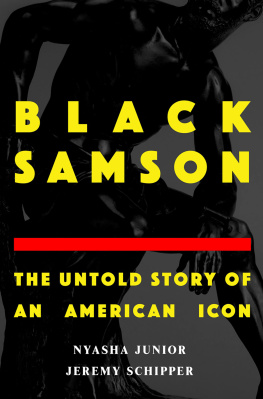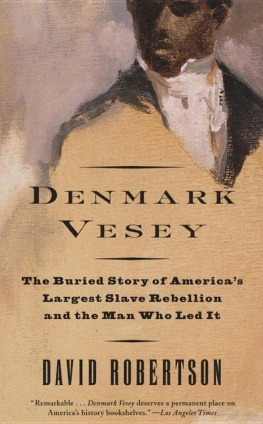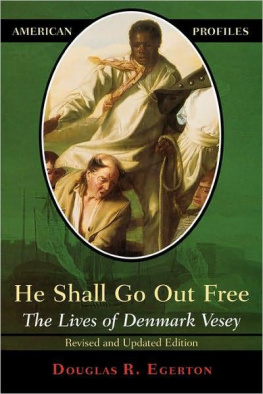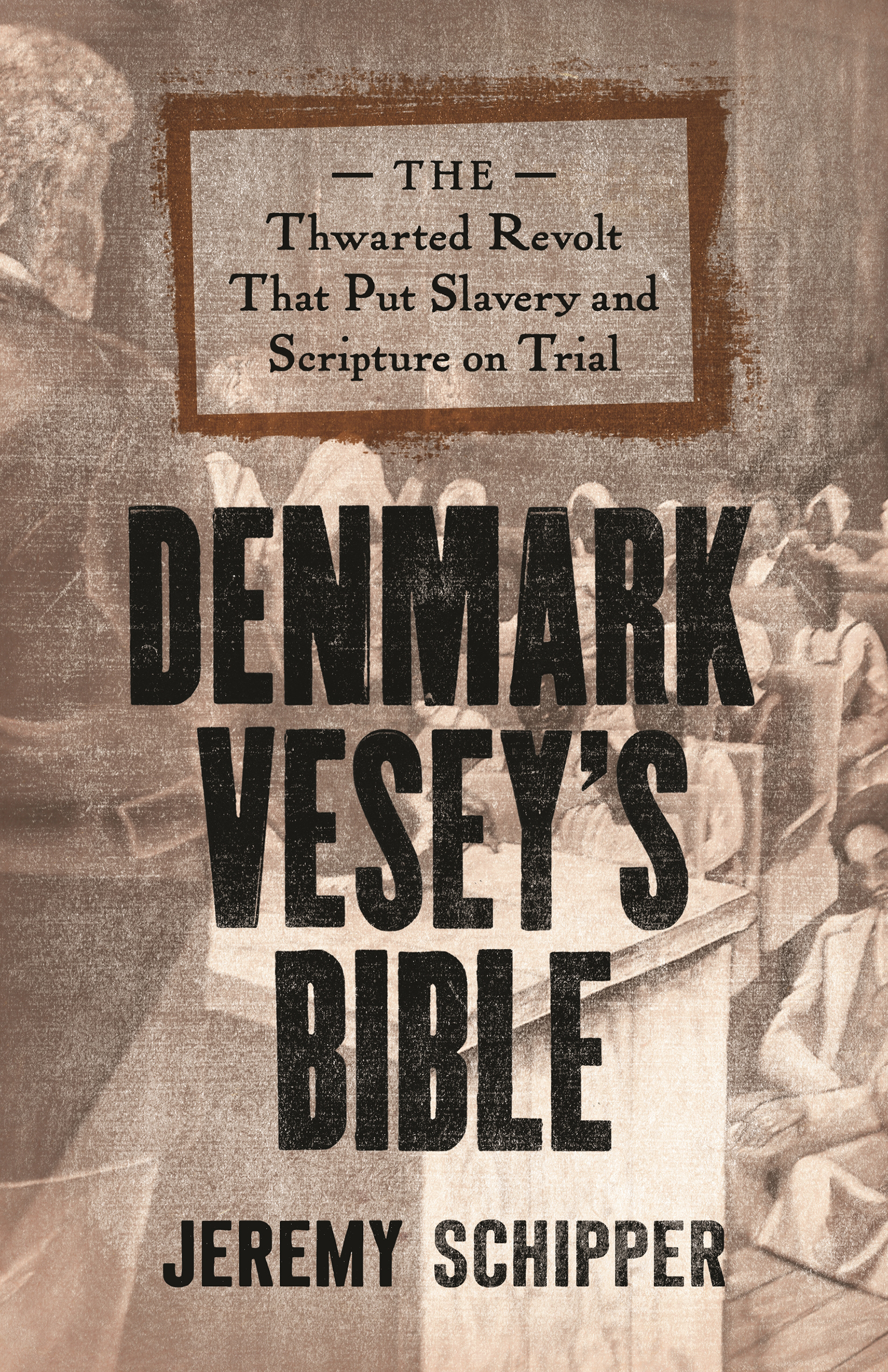DENMARK VESEYS BIBLE
DENMARK VESEYS BIBLE
THE THWARTED REVOLT THAT PUT SLAVERY AND SCRIPTURE ON TRIAL
JEREMY SCHIPPER
PRINCETON UNIVERSITY PRESS
PRINCETON AND OXFORD
Copyright 2022 by Princeton University Press
Princeton University Press is committed to the protection of copyright and the intellectual property our authors entrust to us. Copyright promotes the progress and integrity of knowledge. Thank you for supporting free speech and the global exchange of ideas by purchasing an authorized edition of this book. If you wish to reproduce or distribute any part of it in any form, please obtain permission.
Requests for permission to reproduce material from this work should be sent to
Published by Princeton University Press
41 William Street, Princeton, New Jersey 08540
6 Oxford Street, Woodstock, Oxfordshire OX20 1TR
press.princeton.edu
All Rights Reserved
Library of Congress Cataloging-in-Publication Data
Names: Schipper, Jeremy, author.
Title: Denmark Veseys Bible : the thwarted revolt that put slavery and scripture on trial / Jeremy Schipper.
Description: Princeton : Princeton University Press, 2022. | Includes bibliographical references and index.
Identifiers: LCCN 2021016614 (print) | LCCN 2021016615 (ebook) | ISBN 9780691192864 (hardback ; alkaline paper) | ISBN 9780691212678 (ebook)
Subjects: LCSH: Vesey, Denmark, approximately 17671822Trials, litigation, etc. | BibleBlack interpretations. | Slave insurrectionsSouth CarolinaCharlestonHistory. | Slavery and the church. | Charleston (S.C.)HistorySlave Insurrection, 1822.
Classification: LCC F279.C49 N478 2022 (print) | LCC F279.C49 (ebook) | DDC 975.7/91503092dc23
LC record available at https: / /lccn.loc.gov/2021016614
LC ebook record available at https: / /lccn.loc.gov/2021016615
eISBN 9780691212678 (ebook)
Version 1.0
British Library Cataloging-in-Publication Data is available
Editorial: Fred Appel and James Collier
Production Editorial: Sara Lerner
Text Design: Karl Spurzem
Jacket Design: Emily Weigel
Production: Erin Suydam
Publicity: Kate Hensley and Kathryn Stevens
Copyeditor: Beth Gianfagna
Jacket Credit: Adaptation of Vesey Talking to His People by Dorothy B. Wright. Photo: Rick Rhodes Photography. Courtesy of the City of Charleston, South Carolina
To my brothers, Timothy and James Schipper
Remember Denmark Vesey of Charleston.
FREDERICK DOUGLASS, ROCHESTER, NEW YORK, MARCH 2, 1863
CONTENTS
- xi
- xiii
- xix
- xxvii
- xxxiii
LIST OF ILLUSTRATIONS
LIST OF MAJOR FIGURES
Mary Lamboll Beach (17701851): A local slaveholding widow who, in the summer of 1822, wrote her sister Elizabeth L. Gilchrist several letters with details about the events surrounding Veseys plot (see ).
Batteau Bennett (d. 1822): Enslaved by South Carolina Governor Thomas Bennett Jr., Batteau was one of the five alleged ringleaders executed alongside Vesey on July 2, 1822 (see ).
Ned Bennett (d. 1822): Enslaved by South Carolina Governor Thomas Bennett Jr., Ned was one of the five alleged ringleaders of the plot. Along with Joe La Roche, Ned was said to have attempted to recruit George Wilson to join Veseys plot. Ned was executed alongside Vesey on July 2, 1822 (see the ).
Rolla Bennett (d. 1822): Enslaved by South Carolina Governor Thomas Bennett Jr., Rolla was one of the five alleged ringleaders executed alongside Vesey on July 2, 1822. Along with Jesse Blackwood, he was one of the two alleged ringleaders to confess about the planning of Veseys plot, including Veseys use of biblical texts (see ).
Thomas Bennett Jr. (17811865): The governor of South Carolina during the trial and execution of Vesey and his associates. He enslaved three of the accused ringleaders (Batteau, Ned, and Rolla). John L. Wilson succeeded him as governor later in 1822.
Jesse Blackwood (d. 1822): Enslaved by a local bank president named Thomas Blackwood, Jesse was one of the five alleged ringleaders executed alongside Vesey on July 2, 1822. Along with Rolla Bennet, he was one of the two alleged ringleaders to confess about the planning of Veseys plot, including Veseys use of biblical texts (see ).
Artemas Boies (17921844): A minister at the Second Presbyterian Church, which admitted Vesey into the congregations communion on April 12, 1817. Along with Benjamin Parker and Richard Furman, he was said to have visited Vesey and the other accused ringleaders in jail shortly before they were hanged (see ).
Morris Brown (17701849): Helped to found two independent African Methodist churches in 1818. In August 1822, he was convicted of violating a South Carolina law prohibiting free persons of African descent from leaving and then returning to the state. He was given fifteen days to leave the state. Brown fled to Philadelphia, where he would eventually succeed Richard Allen, becoming the second bishop of the African Methodist Episcopal Church (see the ).
Arthur Buist (17991843): A minister at the First Presbyterian Church. On November 7, 1822, he preached On the Doctrine of Particular Providence, a sermon that interprets the suppression of Veseys plot as an example of Gods active and continued involvement in the world (see ).
George W. Cross (17831836): Denmark Veseys former landlord, who served as Veseys defense attorney at his trial. In 1823, he joined the South Carolina Association, a vigilance organization formed in the wake of the Vesey plot, owing to concerns that laws intended to control people of African descent in Charleston were not rigorously enforced.
Yorrick Cross (lifespan unknown): Enslaved by Veseys attorney, George W. Cross, Yorrick testified about the planning of Veseys plot.
Frederick Dalcho (17701836): Born in London, Dalcho studied medicine in Baltimore before settling in Charleston in 1799. Eventually, he studied theology and became an Episcopal priest, serving at Saint Michaels Church in Charleston until his death. Writing under the pseudonym a South Carolinian, he published a thirty-eight-page proslavery pamphlet titled Practical Considerations Founded on the Scriptures, Relative to the Slave Population of South-Carolina. The pamphlet makes a case that while the Bible does not prohibit slavery, it requires religious instruction for everyone, including enslaved persons (see ).
Henry Drayton (d. 1837): Helped found two independent African Methodist churches with Morris Brown in 1818. Along with Morris Brown, he was convicted in August 1822 of violating a South Carolina law prohibiting free persons of African descent from leaving and then returning to the state. He was given fifteen days to leave the state (see the ).
Benjamin Elliott (17861836): A native of Charleston who trained as a lawyer in Princeton, New Jersey, at an institution then known as the College of New Jersey (later renamed Princeton University). Writing under the pseudonym A South Carolinian, Elliott published a proslavery article about Veseys plot titled To Our Northern Brethren in the local newspaper City Gazette and Commercial Daily Advertiser. Elliotts article includes several key biblical texts, not mentioned in the published trial transcripts, that Vesey and his associates allegedly used to promote the plot (see ).
John Enslow (d. 1822): Enslaved by a merchant named Joseph Enslow, John testified regarding Veseys use of Exodus 21:16 among other biblical texts. Charlestons mayor, James Hamilton Jr., described the evidence John provided as much appreciated by the Court. John died while imprisoned in the workhouse awaiting his banishment (see the ).








